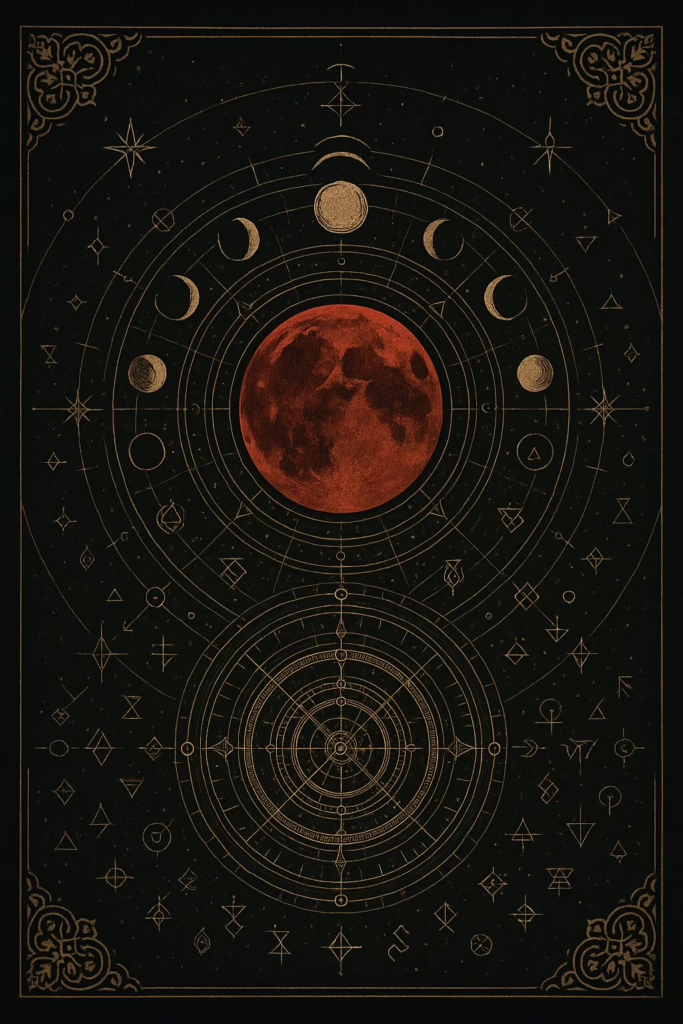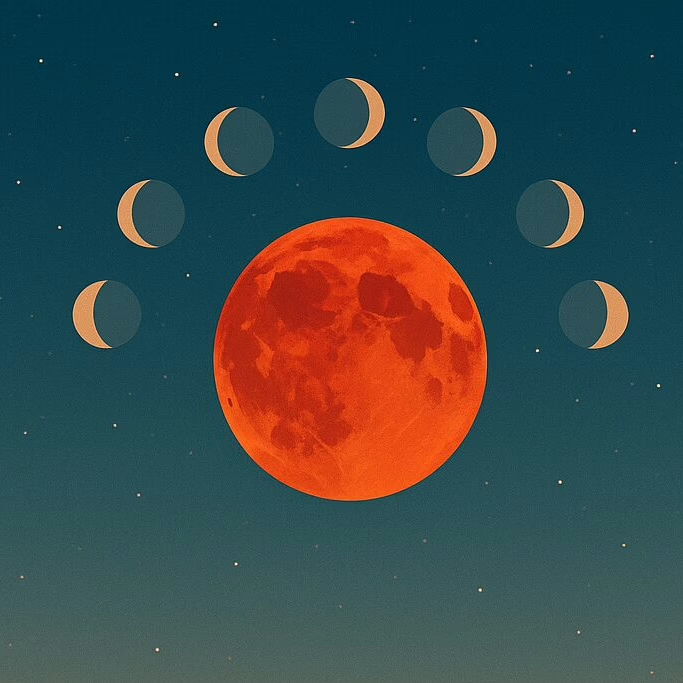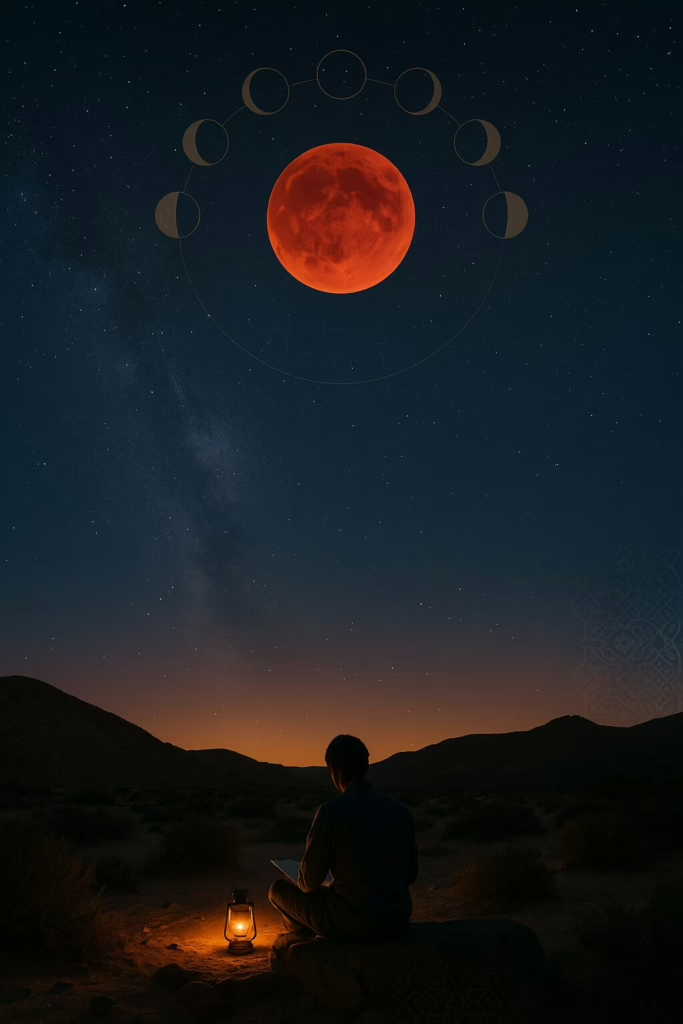Snippet: A blood moon is the red glow of a total lunar eclipse, created when Earth’s shadow and our atmosphere filter sunlight so only rusty reds reach the Moon. Spiritually, many people treat it as a marker for transformation, release, and intention setting, aligning their rituals to sacred timekeeping and the wider rhythms of the sky. NASA Sciencetimeanddate.com
What is a Blood Moon, scientifically?
During a total lunar eclipse, Earth slides between the Sun and the Moon. Sunlight bends through Earth’s atmosphere, blue wavelengths scatter, red tones pass on and paint the Moon copper or crimson. That optical filtering explains the color, not a cosmic omen. NASA ScienceSpacetimeanddate.com
Fresh sky note for 2025: The next total lunar eclipse occurs on September 7, 2025, mainly visible in Africa, Asia, and Australia. The Americas miss this one, yet it remains a perfect moment for reflection and ritual anywhere. WIRED

Blood moon spiritual meaning
Across many traditions, a blood moon symbolizes change, culmination, and renewal. People use it to close chapters, grieve what is ending, and name what should begin. That story of endings and beginnings mirrors the eclipse itself, a brief darkening followed by returning light. Treat the symbolism as a tool, not a rule. Original Botanica
Amplified inner work: Practitioners often report heightened intuition, clearer boundaries, and a pull toward meditation, prayer, or journaling that night. Consider it a scheduled pause, a cosmic appointment with your interior life. Original Botanica
Blood Moons and sacred timekeeping: aligning with cosmic rhythms
Long before wristwatches, communities tracked months and seasons by the Moon, assigning names like Harvest Moon or Flower Moon to guide planting, gathering, and ceremony. That is sacred timekeeping, a calendar of meaning as well as dates. You can borrow the habit today to pace growth, rest, and reflection. almanac.comtimeanddate.com
How to align without dogma:
- Name your cycle: Use a 29.5-day Moon cycle to plan intentions, check-ins, and reviews. Mark eclipse nights as “deep audits.” almanac.com
- Track seasonal cues: Pair full-Moon names with small actions, for example gratitude at the Strawberry Moon or decluttering near Harvest Moon. timeanddate.com
- Honor culture respectfully: Many Native nations hold distinct eclipse teachings. Learn from sources created with those communities, avoid blanket claims, and cite them. smithsonianmag.com
Check your work: Did you note the exact date, your time zone, and whether the eclipse is visible locally?
Cultural perspectives, briefly and respectfully
Indigenous nations in what is now the United States hold diverse eclipse teachings and practices, often emphasizing community, prayer, and balance. These views are not interchangeable, so seek tribe-specific resources from museums and Native authors when learning or planning observances. smithsonianmag.com
Astrology and the blood moon, clearly labeled
In astrology, a blood moon is a super-charged full Moon, often framed as a time of revelations, closures, or fate-colored turning points. If you use astrology, you might cast the moment as a checkpoint on long-running themes rather than a prediction machine. Treat this as belief, not science. Yoga Journalastrologyzone.com
Myths, safety, and common sense
Eclipse superstitions persist, for example warnings to pregnant people. Medical science does not find eclipses harmful to pregnancies. If any ritual or restriction eases your nerves, that is fine, yet keep it in the lane of comfort rather than fear. Live Science

A simple blood moon practice you can try tonight
- Prepare a page: Title it “What ends, what begins.”
- Breathe and notice: Name one habit, belief, or situation that is ending.
- Declare a start: Name one concrete action that begins this week.
- Protect the boundary: Pick a small safeguard, like a bedtime or screen-free hour.
- Close with gratitude: Write one line of thanks for the lesson.
Check your work: Is your “start” measurable, time-bound, and kind to future-you?
Quick facts
- A blood moon is the visible color of a total lunar eclipse, caused by atmospheric filtering of sunlight. NASA ScienceSpace
- Many cultures used Moon names for seasonal timekeeping, a practice you can adapt for goals and rituals. timeanddate.com
- Astrological meanings are interpretive traditions, not scientific claims. Yoga Journal

FAQ
What is the blood moon spiritual meaning in one line?
A timely prompt to release what is done and commit to a next chapter, aligned with the eclipse’s light-into-shadow-into-light rhythm. Original Botanica
Is a blood moon dangerous?
No. The red color is atmospheric physics, and there is no evidence of harm to health or pregnancy. NASA ScienceLive Science
How do I use it for manifestation?
Pair the date with specific, realistic tasks, then review at the next full Moon. Make it a calendar you live, not a wish you wait for. timeanddate.com
What if I cannot see the eclipse from my city?
You can still observe, journal, or gather. The ritual is about timing and attention, not line-of-sight. WIRED
Conclusion
A blood moon blends clear science with optional symbolism. Use the eclipse as a scheduled pause, a checkpoint for closure and beginnings, and an anchor for sacred timekeeping that respects culture and evidence. Treat meaning as a craft project, build it with care, and let the night sky keep good time with you. NASA Sciencetimeanddate.com
Sources
- NASA Moon: “What You Need to Know about the Lunar Eclipse.” . NASA Science
- Timeanddate: “What is a Blood Moon?” . timeanddate.com
- Space.com: “Why does the Moon turn red during a total lunar eclipse?” . Space
- Smithsonian Magazine, NMAI Blog: “What Indigenous Americans Believe About Eclipses.” smithsonianmag.com
- Old Farmer’s Almanac: Full Moon Names. . almanac.com
- Timeanddate: Traditional Full Moon Names. . timeanddate.com
- LiveScience: “Myths Aside, Eclipses Don’t Endanger Pregnancies.” . Live Science
- Wired: “How to See the Total Lunar Eclipse and Blood Moon on September 7.” . WIRED
- Yoga Journal: “What is a Blood Moon?” . Yoga Journal
